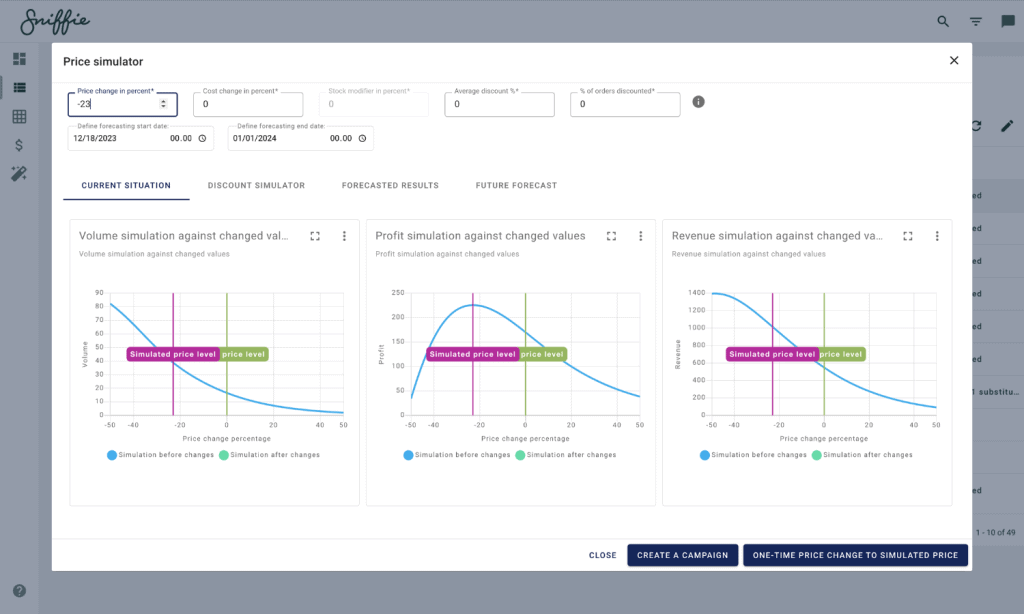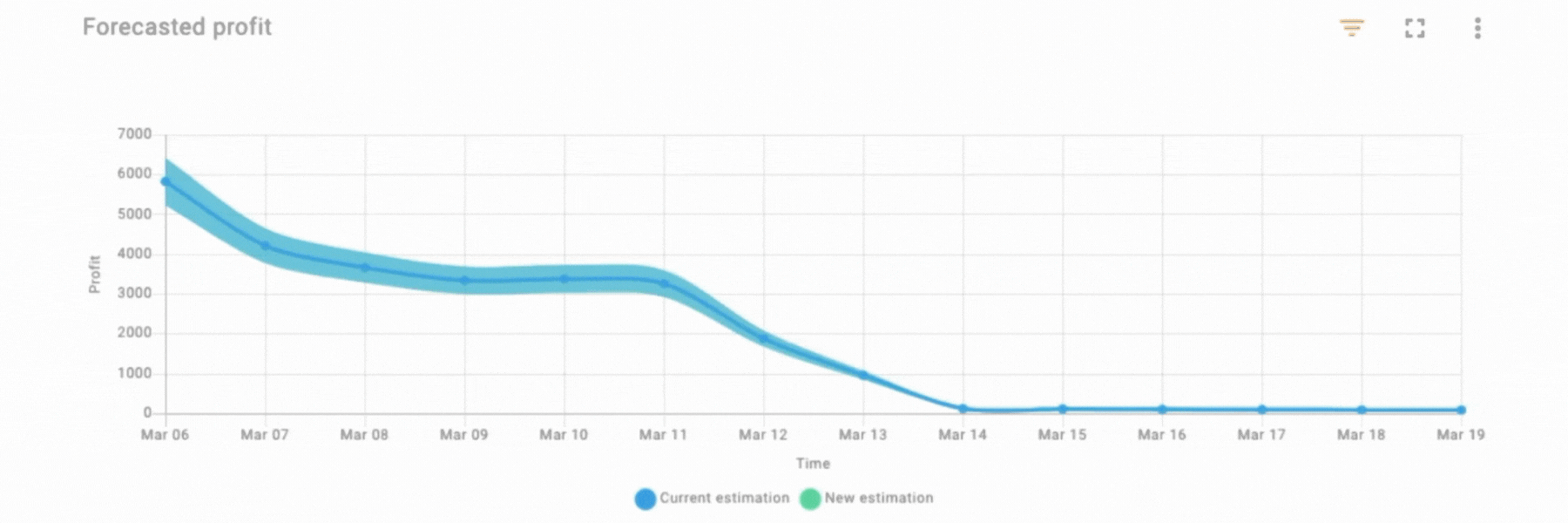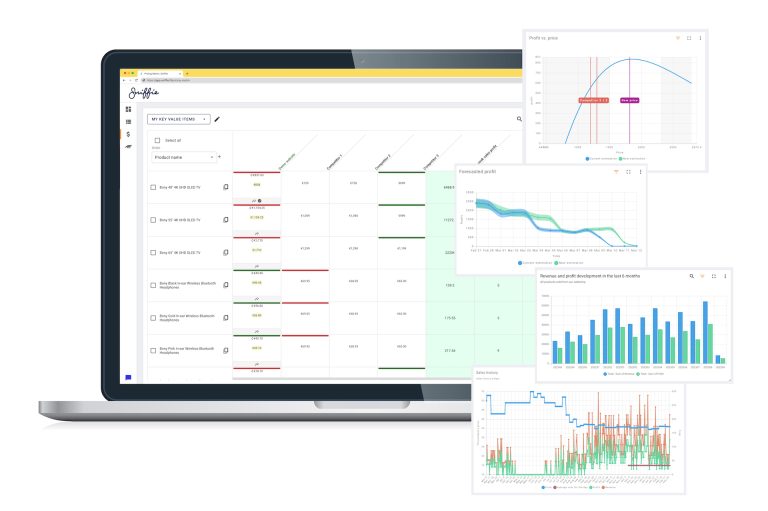Demand forecasting is often seen a complex task, yet, in a data-driven world it is easier than you think. You may need to know how much revenue and profits your pricing campaign is expected to generate. Likewise, how much your dynamic pricing requires inventory and how often you need to replenish stock. Demand forecasting answers all of these. Especially important in eCommerce where the competitor pricing is fierce.
We’ll discuss all you need to know about demand forecasting and provide you with tips to help with the process.
Jump directly to a topic:
Simulate your prices with demand forecasting
Identify optimal price points and discount percentages to drive your business growth.
All from one tool.

Let's chat about pricing!
Fill out the form to see how Sniffie can help you with all of your pricing problems and optimize your pricing effortlessly!
What is demand forecasting?
Demand forecasting is the process of understanding and estimating future customer demand over a specific period. Generally, it will involve historical sales data with seasonal variances and other information to provide the most accurate predictions.
Examples of demand forecasting
To give you a fundamental understanding, think of an eCommerce store that sold 100 winter jackets in November, 150 in December, and 200 in January. As humans, we can assume that there will be a demand for approximately 250 units in February if the market conditions remain the same. But your prediction might be much more accurate when you have historical seasonal data. For example, earlier years might show that February people already focus more on buying spring clothing. Thus, the sales expectation would be 90 units.
A more complex example is a grocery store preparing its inventory for this year’s Thanksgiving week. They are looking at sales data from previous years for seasonal products like turkeys, cranberries, and potatoes. Last year was a good year, generating high sales. But six months ago, another grocery store close by just opened and used dynamic pricing software to respond to our pricing.
In addition, many families have continued to move into the neighborhood, which has increased the store’s average sales increase by 1% month by month. Furthermore, they plan to launch more ads with a higher budget this year. Calculating all these factors (and other relevant ones), the demand forecast has estimated a 5% increase in sales compared to last year.

Sniffie’s Price Simulator allows you to accurately predict future volumes and profits for your products based on their historical performance and seasonal trends.

Why is demand forecasting important?
There are several reasons why demand forecasting is essential for companies:
- It assists pricing with business planning, goal setting, budgeting, and estimating profit margins. You can establish an understanding of future sales and build an informed plan. Production planning and future capacity planning are other things to could be initiated. With demand forecasting, you can ensure that your supply matches the demand.
- It allows companies to optimize their inventory, increase turnover rates and reduce warehousing costs.
- It provides insight into upcoming cash flow. You will create a more accurate budget regarding suppliers and other operational expenses. It also enables you to invest more in business growth (capital expenditures).
- It can identify and resolve any issues in the sales pipeline and supply chain operations to ensure the business runs smoothly 24/7. Regarding inventory management, most eCommerce companies know cash bound into stock will damage operations.
- Anticipating demand also means companies can know when to increase staff and other resources in advance. It is necessary to keep the operations running well during peak times.
Without demand forecasting, you are making poor pricing decisions. In addition, it will affect pricing, warehousing costs, customer satisfaction, supply chain management, and profitability.
Why do e-commerce and retail businesses need demand forecasting?
Demand forecasting is essential for eCommerce companies. Especially if you use dynamic pricing or pricing campaigns heavily to drive your business. You can make intelligent business decisions when you understand the demand and how your pricing changes it. Below are just a few benefits of demand forecasting:
Identify seasonal trends
Analyzing past monthly sales performance can help identify seasonal fluctuations, such as peak seasons. However, it is equally important to identify the seasons with less customer demand. Lowering demand can be an opportunity to present pricing campaigns or do a markdown pricing strategy to increase customer purchases.
Manage the cash flow
Cash is king. Your capabilities to release cash or invest more in growth will significantly improve when you know how your pricing affects the demand.
Better planning of supply chain
Demand forecasting can anticipate in advance customer demand spikes by securing enough inventory levels. As a result, you can avoid incurring rush charges and putting backorder.
Understand the impact of external factors on product sales
Forecasts can involve external data such as macro economy, industry trends, projection of the market sector, etc. Calculating these factors can help to be more agile and adaptive to future conditions to grow a business.
Anticipate the future
Every company must be ready for all circumstances, whether natural disasters or new competitors. Demand forecasting helps prepare the supply chain and the company for future scenarios.
Why machine learning and AI are the future of product pricing
AI is a buzzword like no other. We sat down, wrote all we know about it and let you be the judge. Here is a seriously indepth 50-page insights on how to use artificial intelligence in pricing. Hope you find it useful!

The most common issues with demand forecasting
To perform effective demand forecasting, you need accurate and robust data. Unfortunately, issues faced by most companies are related to missing data. Below are other significant problems that can hinder your demand forecasting process:
Lack of historical sales data
The most common problem is the lack of data. Even established companies struggle with this. To use demand forecasting effectively, you need sales history data. To avoid this, collect all the past sales data and organize it in one place and in an easy-to-use format.
Poor supply chain management
The best demand forecast will not help your business if the supply chain is not well-managed. It is essential to know the exact lead times needed to source the raw materials, produce finished products and ship them to warehouses. In addition, it makes it easy to solve any issues that block the production process swiftly.
Lack of inventory control
Some people say good inventory management is the foundation of good demand planning. Indeed, if you don’t clearly understand what you have in stock, it might lead to an overestimated or underestimated production plan.
Large SKU assortment
Processing a large SKU assortment using only spreadsheets and manual calculations takes substantial time and resources. Instead, demand forecasting tools use machine learning and artificial intelligence that can automatically calculate numerous amounts of data and variables, which is much more helpful and resource-saving.
What factors influence demand forecasting?
Several factors affect customer demand. Something to consider before forecasting. Let’s see how different factors influence demand forecasting:
1. Seasonality of product sales
Seasonality refers to a high variation of product demand throughout the year. A highly seasonal product may serve only for a specific period or event, leading to a high sales volume during this peak period. Outside these peak periods, sales will return to a regular state / steady or slow down.
Some demand forecasting examples based on seasonality are products sold:
- during specific seasons: grilling equipment in the summer and snow sleds in the winter
- during specific events: chocolates on Valentine’s day
- during specific periods: school equipment in August before the start of a new school year
Thus, during the off-season, companies must reduce inventory for seasonal products but increase production during peak seasons.
2. Competition
Competition has a direct impact on demand. As a result, customer demand can either drop or spike whenever competition enters or exits the market.
When a new player enters the scene, an existing player may suffer as customers have more options. But when the opposite happens (when a business closes), existing players may have greater demand from consumers.
3. Type of goods
Different products and services of different natures affect demand forecasting. For example, perishable goods with a short product life cycle/expiration date must have an exact demand forecasting number. Otherwise, a lot of stock is in risk of going to waste. On the other hand, demand forecasting for monthly magazine subscriptions can be less exact.
4. Geography
The geographical location of your customers and where you manufacture, store and deliver orders can significantly impact inventory forecasting, shipping cost, and delivery time. Shipping cost is one of the driving forces that makes e-commerce pricing more critical than ever.
So, it is essential to be strategic when choosing geographical locations for your retail supply chain. For example, choosing a warehouse close to where most of your customers reside can help you fulfill your customer orders faster. Also, this comes at a more affordable cost, as you don’t have to store products in a faraway place.
5. Economy
When the economy falls into recession and fewer people work, the demand for luxury products will decline. But, at the same time, demand for affordable products will likely increase.
Want to try out Sniffie?
Take a spin of our app to get a thorough outlook on how we could support you. Just contact us, and we’ll get you access.
Let's chat about pricing!
Fill out the form to see how Sniffie can help you with all of your pricing problems and optimize your pricing effortlessly!

To sum up...
Demand forecasting provides essential information about future customer demand; it assists companies in making more intelligent decisions about production planning, inventory management, and supply chain operations.
It also helps with profit margins, cash flow, capital expenditures, future capacity planning, and more. Demand planning based on sales data, market research, and economic factors will help any business thrive.



